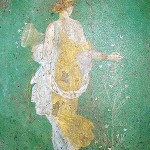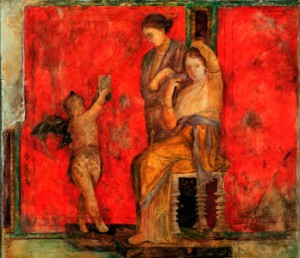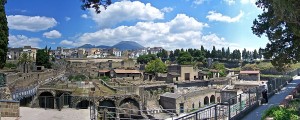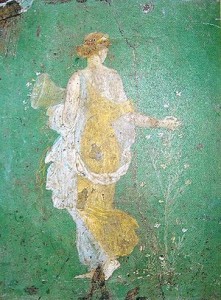On August 24, 79 AD, the volcano Vesuvius erupted and completely covered the cities of Pompeii, Herculaneum, and the surrounding area in molten ash and pumice. Days before, Vesuvius began spitting smoke and ash, prompting the evacuation of many residents. Those who stayed behind were killed on contact by the toxic fumes, frozen in their moment of horror. Their misfortune has become our fascination as the ancient Roman cities were preserved exactly as they were on the day the volcano blew, giving us moderns impressive insights into the everyday life of the ancients.
Back in its heyday, Pompeii was a well-off, bustling Roman city. It was a trading town that exported wine and fish throughout the Empire. Wealthy families owned elaborate villas; there were baths, theaters, and gyms complete with swimming pools. Bright frescoes decorated the walls of even the most modest dwellings, while the rich lived it up in grand style with elaborate frescoes, statues, fountains, and mosaics.
Graffiti seems to be as common in Italy then as now and ranged from lovers’ devotionals to political statements. Most surprising is the erotica that covered walls. The most controversial—so much so that the Pope declared these frescoes unfit for children to view — were recently discovered in the swimming pool’s changing rooms. Though it was most often bedrooms that sported such decoration.
Pompeii was accidentally discovered in 1600. Surprisingly, excavations didn’t begin until 1748, headed by the Bourbon king of Naples, but haven’t stopped since. The best booty discovered in the eighteenth century was carted off to the Bourbon’s palace in Naples, now open to the public as the Museo Archeologico Nazionale. Yet there are still some wonderful paintings and mosaics to be seen in Pompeii, and nowhere else in the world can you get such a satisfying glimpse into the lives of those who lived nearly two thousand years ago.
Stroll through the houses of the upper-middle classes, such as the House of the Vettii—one of the best maintained—and House of the Faun, so named because of the statue of a faun (the original is in Naples) dancing in the atrium’s fountain. Then there is the Palestra, or gym, with its swimming pool, and the Amphitheater that could hold over half the town.
Don’t miss the Villa dei Misteri, a third century BC house. The villa’s name comes from the brilliant life-size fresco all around the walls, thought to be scenes of a woman preparing for the initiation rites into the Dionysian Mysteries. The brilliant figures jump out at visitors from their bright red background.
One of the more morbidly fascinating sights of Pompeii are the plaster casts made from victims’ bodies. You will not see them everywhere, but they are scattered around the site to stir up the imagination.
If you have some days to spare and are interested in visiting more of the archeological sites around Pompeii, buy an inclusive ticket for only 10€ more. The ticket is good for three days. An added visit to Herculaneum alone would be worth it.
Herculaneum
The smaller, wealthier town of Herculaneum had the bad luck of being located nearer to Mount Vesuvius than its neighbor Pompeii. Herculaneum is also a smaller and better preserved archeological site, making it easier to walk around and understand in an afternoon.
Herculaneum was accidentally discovered in 1709 by a man digging a well. Unfortunately, excavations and looting followed. Bronze and marble statues were carted off to decorate rich palaces throughout Naples, and it wasn’t until 1927 that digging and preservation finally began in earnest. It was thought that many of the residents managed to escape the explosion in good time, but recent findings have proved this to be false. At least three hundred skeletons have been found in boat houses on the seashore.
Unlike Pompeii, Herculaneum was a residential town, so there were plenty of villas, shops, and even a bath, but there wasn’t a central forum or open spaces. The town’s shops can be found along Cardo V: a bakery complete with ovens and grinding mills; a weaver’s shop with a loom; and a dye house with its huge dye pots still visible.
The most famous, and opulent, of Herculaneum’s villas is the Villa of the Papyri. The villa was so named because a room of carbonized and unfortunately unreadable scrolls of papyri was found on the grounds. The villa was decorated with over 80 sculptures, and curiously, it was replicated on a grandiose scale by J. Paul Getty as his museum in Malibu, California.
Villa Oplontis, Boscoreale, and Stabiae
In the area around ancient Pompeii and Herculaneum were several other enclaves of dwellings, many of them built for the rich who came to live here for the wonderful views out over the bay. Villa Oplontis, Boscoreale, and Stabiae have frescoes to be seen in their wealthy villas.
The luxury resort of Stabiae wasn’t that old when it was destroyed by Mount Vesuvius. In 89 BC Sulla came through with his troops and knocked it to the ground. But Stabiae was rebuilt and made even more opulent than before. It was here that Pliny the Elder died on the day after Vesuvius’s eruption. As his nephew Pliny the Younger reports, he ventured out on his boat to save victims, but ended up dying himself.
Mount Vesuvius
If you want to witness firsthand the volcano that wrought all this destruction, take a climb up Mount Vesuvius on your next Italian vacation. The last eruption was in 1944, and scientists say there’s no need to worry about another one any time soon. The reddened, barren gravel and rocky walkway would be like something out of an apocalypse movie, if Naples’s urban sprawl wasn’t so visible below. It’s a stony and somewhat strenuous walk up, but you can enjoy refreshments at the top, and of course, most rewarding, a glimpse into the crater!
Make sure you check out our Pompeii Travel Guide!
-
What are you looking for?

Scotland was amazing, we really enjoyed ourselves.
The weather was nice most of the time and we saw much more than we anticipated. We met up with a distant cousin of my husbands and had a nice visit. Each town was more charming than the next. The tours were great and we really liked the guides. We look forward to...Susan McCann
Customized Trip to Scotland, April 2018-
Blog Categories











